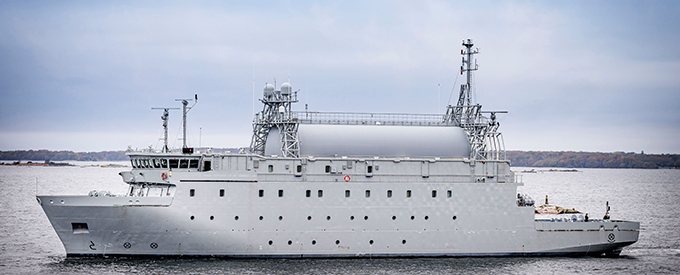2023-01-01
Saab to Design Two SIGNIT Ships for Poland
Saab recently signed a contract with the Polish Ministry of Defense’s procurement authority, Armament Agency, for the design, production and support of two SIGINT (signals intelligence) ships. All conditions of the agreement have been met, and Saab has booked an order value of approximately SEK 6.7 billion.
Saab will be the main supplier and design and be responsible for the production and integration of advanced mission systems on board the two ships. Polish subcontractor Remontowa Shipbuilding SA will build the ships. The deliveries are planned for 2027.
Significance of a SIGINT Ship
An immense number of electronic signals constantly surrounds us. They come from radio transmissions, mobile phones and radars, among other sources. Most of this communication is civilian, but there is also a significant number of signals with military origin in the air.
A SIGINT ship is used to support intelligence data acquisition across the full spectrum of naval intelligence capabilities.
Registering and analysing different types of military signals allows a nation to get an overview of the normal behaviour of signal traffic in the surrounding area.
This creates a picture of the types, amount and behaviour of signals you would normally expect to find there. If the normal picture changes, gradually or suddenly, you would want to understand the reason for the changes. These analyses can form the basis for military and security-related decision-making.
All types of radio- and radar systems emit signals with a signature that is unique for that particular type. By registering the signatures, it is possible for a nation to build up a signature library.
Analysing and positioning signals from vessels, aircraft or ground forces makes it possible to follow their movements, displaying them on a map in real-time. And by comparing the signals’ unique signature to the signature library, it is possible to determine which type of emitter the signal comes from and identify the type of vessel emitting the signals.
Leveraging Data
Saab’s experience in developing complex systems featuring passive sensors and data fusion goes back decades. The company’s system consists of advanced and sensitive sensors combined with the capabilities and tools to sift through huge amounts of signals and data to extract what is interesting and relevant.
There are different types of passive sensors depending on what is the most pressing need. Typically, it is a compromise between picking up something very far away or making sure you pick up everything around you. The different sensors’ characteristics complement one another and are optimised for their specific tasks.
This allows the user to pick up individual signals, even at great distances, and perform highly accurate measurements on them or to get wide coverage of the complete radio frequency spectrum and immediately detect communication- and radar signals.
To draw correct conclusions, you also need the means to handle the collected information. For this reason, a system has robust and selective algorithms and methods for identifying and classifying radar and communication signals. These processes are automated, and a high degree of automation means the operator can focus on critical tasks while keeping the system continuously running with fewer staff during periods with low activity levels.
In addition to the long-term strategic signals intelligence activities, passive sensors are also used for tasks with much shorter time-span, for example, to detect and identify an attacking hostile aircraft. Traditionally, a radar system detects the hostile aircraft, passing its location and speed on to the nation’s own ground-based air defence.
But we can assume that these radar signals are quickly identified by the attacking aircraft’s own passive sensor system. This gives the opponent the possibility to steer the aircraft out of reach of the ground-based air defence or to jam the radar’s signals electronically. Additionally, the radar station’s location is revealed, opening it up for an attack.
In a situation like this, passive sensors detect hostile aircraft by picking up the electronic signals the aircraft emit, radar, speech, or data communication. The passive sensors detect the hostile aircraft without the attacker understanding they are detected, and the air defence radars can stay silent, undetected, until they are really needed.
Having different modern and efficient systems that pick up, understands and can make use of all the signals that surround us are a basic precondition for a nation’s capability of protecting itself against threats, be it in peacetime, crisis or during war.


No Comments